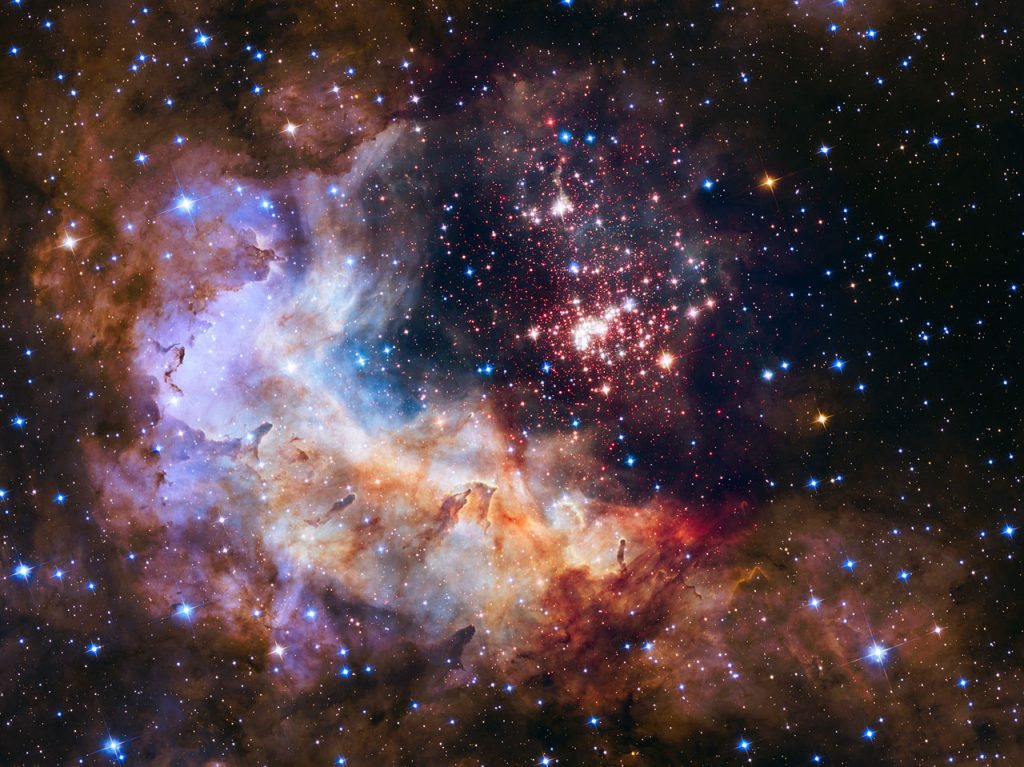Current status of stars
12.30.2016
This NASA/ESA Hubble Space Telescope image of the cluster Westerlund 2 and its surroundings has been released to celebrate Hubble’s 25th year in orbit and a quarter of a century of new discoveries, stunning images and outstanding science. The image’s central region, containing the star cluster, blends visible-light data taken by the Advanced Camera for Surveys and near-infrared exposures taken by the Wide Field Camera 3. The surrounding region is composed of visible-light observations taken by the Advanced Camera for Surveys.
The large black pots for our indoor-outdoor 1.5 kg Baies candles shimmer with a constellation of small golden stars. Stars? Indoor-outdoor? Heavy? Black? Fire? This is a perfume Universe! Appropriate then to find out more about stars…
A star is stable ball of gas that produces energy. Light energy results from the nuclear fusion processes that dilate the star’s core. This thermal expansion process balances out the gravitational forces that try to contract it. In the observable Universe, it has been estimated that there are ten thousand billion billion stars. Every day, billions are born and millions die. The Milky Way, the small galaxy that is home to our sun, has one to two hundred billion stars. And there are probably a hundred billion galaxies. These galaxies are grouped in clusters, which form larger homogenous superclusters in the Universe. Astrophysicists can’t specify whether stars are grouped in galaxies or, on the other hand, whether the original superclusters have split into sub-groups with stars being the unifying factor. Gravitational forces condense the structures and organise the celestial bodies accordingly. All this would have happened between 400 thousand years ago and a billion years after Big Bang. Theoretically speaking, Big Bang is the birth of the Universe and therefore of space. Space is expanding. The current diameter of the Universe is 82.8 billion light years. According to Einstein’s Theory of General Relativity, distance is relative to velocity, and therefore space and time are relative concepts. Space and time are can therefore be deformed and curved by the trajectories of celestial bodies. Gravitation is the natural manifestation of the curvature of space-time. Not rocket science so far. And not too hard to get your head around.
One day, having used up all its nuclear fuel resources, the star explodes and collapses under its own weight. If its mass is less than 8 times that of the sun a white dwarf is born. If its mass is between 8 and 40 times that of the sun, its explosion produces a supernova and creates a neutron star or pulsar. If the mass of the star is even larger than that, no known repulsive force inside a star can push back hard enough to prevent gravity from completely collapsing the core into a black hole. It is localised by the velocity of the elliptic trajectory of stars which can only be explained by the existence of a vast invisible mass that is accelerating their trajectory. This object, the black hole, is implicated – but many observations corroborate its « existence ». And what if this black hole has an exit point through which it could restore the material that had been engulfed? This would be a wormhole, a theoretical shortcut through the Universe like the tunnel created by a worm in an apple: this would open up another part of the Universe and shorten access by distorting the space-time continuum. It could also provide access to other Universes. Stephen Hawkings cleverly quipped that the absence of tourists from the future is an argument against the existence of backward time travel, because until a time machine were actually to be invented, we would not be able to see time travellers…
All this knowledge is strictly hypothetical of course: the matter from which stars, celestial bodies, planets and nebulae have been formed only amounts to 4% of the total mass and energy in the Universe. All this mass and energy contains 96% of absolute unknowns that have been mathematically conjectured: 22% of dark matter and 74% dark energy, a force antagonistic to gravitational forces that would explain the extension of the Universe. As for the stars, they will have died off in a thousand billion years, due to the lack of gas to produce new ones. They will evaporate… All that will remain are: stellar debris, white dwarves, neutron stars, dwarf stars, planets, rock asteroid bodies and black holes…Later on in time these too will evaporate. But the collapse of neutron stars might produce more of them, which will also evaporate… Which begs the question if the Universe itself was born under a lucky star.
And memento want to wish you a year of light ahead…
All this summarised information comes from various conferences run by Jean-Pierre Luminet at the Laboratoire Univers & Théories de l’Observatoire de Paris – Meudon. He is an astrophysicist, a research director at the CNRS and a writer, who likes to quote the following poem:
Sometimes nights are so clear
That they are like a call
There may be so many stars
But in this solemn jumble
Even if you can distinguish some
Stars here and there:
They are the condemned.
(Eugene Guillevic)

